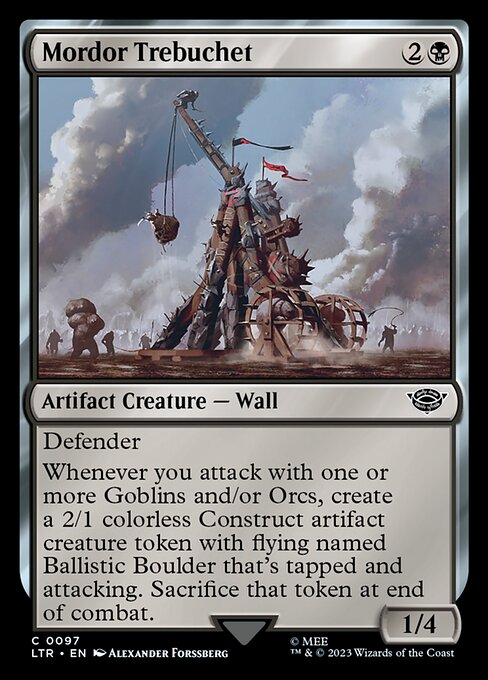
Image courtesy of Scryfall.com
Rarity Scaling and Set Balance in The Lord of the Rings: Tales of Middle-earth
Magic: The Gathering has always wrestled with the question of where power should live across rarities. In most sets, the loud, “watch-me-win-the-game” moments live at mythic and rare, while common cards quietly shape the tempo and texture of the game. The Lord of the Rings: Tales of Middle-earth continues that conversation by weaving classic MTG design lessons into a thematic, high-interest world. A standout example is Mordor Trebuchet, a common artifact creature with a Defender that still manages to influence the board in surprising, tempo-forward ways 🧙♂️🔥.
Designers deliberately calibrate rarity to support both limited and constructed play. Common cards like Mordor Trebuchet are the backbone of draft archetypes, offering consistent, approachable power without eclipsing the more explosive rares and mythics. In this set, the “draft_innovation” frame invites players to explore hybrid strategies—Goblins and Orcs, plus a little Mordor hardware—without tipping the balance into unfun, unanswerable territory. The set’s black mana identity in Mordor Trebuchet’s color profile anchors a defensively slanted game plan, while the triggered offense from attacking Goblins/Orcs adds a twist that keeps players honest about tempo. The end result is a design space where rarity scaling feels intentional: you get meaningful, fun swings at common, while bigger plays remain the purview of higher rarities. ⚔️
At a glance, Mordor Trebuchet looks like a modest early-game roadblock: a 1/4 artifact creature with Defender for three mana (2B). That stat line is a classic “wall with something under the hood” blueprint. The real spice arrives when you start attacking with Goblins and/or Orcs: you generate a 2/1 colorless Construct named Ballistic Boulder that’s tapped and attacking. That token blitzes in as a surprise—two bodies merging into pressure, with flying to complicate blockers. But the token isn’t forever-free: you Sacrifice it at end of combat. It’s a temporary, tempo-driven payoff that keeps the board state evolving and the opponent guessing. This kind of conditional, on-attack payoff is exactly the kind of spice designers crave for a common slot: enough to matter, not enough to warp the long game. 🎨
The strategic heartbeat: how it plays out on the table
In limited formats, Mordor Trebuchet shines as a stabilizing piece in a Goblin/Orc-leaning deck. The Defender ability means it can soak up early aggression, buying you time to assemble a more threatening board while your smaller creatures chip away. The real trick is leveraging the conditional payoff: when you swing with your Goblins and Orcs, you don’t just press for damage with your creatures—you summon a temporary Ballistic Boulder that can threaten a surprising amount of damage, especially if you have a quick synergy-based deck that wants to push through with evasive reach. The token’s flying keyword makes it awkward for opponents to block efficiently, which is a textbook tempo swing. And because the Boulder token is sacrificed at end of combat, you’re not bloating your board with material you can’t recover—your plan is to pressure, not to swamp. 🪄
From a set-balance lens, this card nudges players toward interactive, tribal play without creating an overpowering combination. It rewards you for leaning into Goblin/Orc themes—two archetypes that often need a little extra support in black-green-black-red-leaning stacks—while staying firmly within the common rarity. The design also respects the broader LOTR narrative: the Trebuchet is a tool of Mordor, not a master strategist; it’s a force-mort for a moment, not a perpetual engine. The single-card payoff by attacking with specific creature types provides a predictable, skill-testing beat that supervisors can tune across drafts. And yes, it’s a flavor win, too—the image of a siege weapon waking up Goblins to swarm feels delightfully thematic, a moment of nostalgia wrapped in a modern game mechanism. 🧨
Practical takeaways for deck building
- Tempo over raw power: harness the Defender body to slow the ground game, then flip the script with Goblin/Orc swings that trigger the construct token. The result is a nuanced, tempo-forward plan rather than a brute-force slugfest. 🧙♂️
- Token economy matters: the Ballistic Boulder token creates value in the moment and then disappears. Don’t overcommit to creating a sprawling battlefield—your goal is to pressure, then reset after combat. ⚔️
- Color identity and synergy: black-leaning boards can maximize removal and disruption while supporting tribal synergies. Mordor Trebuchet invites you to weave card economy with board presence rather than chasing a single, overwhelming play. 🔥
- Draft pacing: common cards like this keep archetypes viable in draft, letting players develop Goblin/Orc and artifact themes without displacing rare engines. It’s a gentle nudge toward diverse builds. 🎲
- Collectibility and value whisper: while its printed rarity is common, the card’s utility can vary by environment. In some tables, Mordor Trebuchet becomes a stalwart anchor; in others, a clever throwaway that prompts a dynamic swing. 💎
For collectors and players who savor the synergy between lore and game mechanics, Mordor Trebuchet is a crisp example of how rarity scaling and set balance support a flavorful, accessible experience. It isn’t about oversaturation or gimmicks; it’s about giving players meaningful choices at every step of the game. And in a set where the Ring-bearer’s shadow looms large, a practical, clever weapon like this helps keep the game both familiar and fresh. 🎨
If you’re curious to explore more about how artists and designers balance products, layout, and timelines, our network has you covered with thoughtful takes and practical guidance that translate from tabletop to the digital realm. Also, if you’re looking for a real-world companion to your MTG sessions, check out this sleek case: Lime Green Abstract Pattern Tough Phone Cases Case Mate — a stylish way to keep your gear safe between rounds.
Product spotlight and discovery go hand in hand with a good game plan. Ready to explore more?
Lime Green Abstract Pattern Tough Phone Cases Case MateMore from our network
- https://transparent-paper.shop/blog/post/monetizing-digital-zine-layouts-a-creators-guide/
- https://blog.digital-vault.xyz/blog/post/the-art-of-building-long-lasting-products/
- https://blog.digital-vault.xyz/blog/post/unlock-sleek-modern-layouts-with-minimalist-digital-paper/
- https://blog.digital-vault.xyz/blog/post/build-effective-project-planning-dashboards-that-drive-results/
- https://blog.digital-vault.xyz/blog/post/lampent-inspired-fan-games-ghostly-design-in-pokemon-mods/